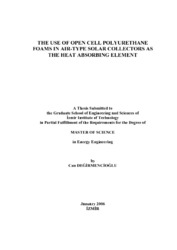Please use this identifier to cite or link to this item:
https://hdl.handle.net/11147/3253Full metadata record
| DC Field | Value | Language |
|---|---|---|
| dc.contributor.advisor | İlken, Zafer | en |
| dc.contributor.author | Değirmencioğlu, Can | - |
| dc.date.accessioned | 2014-07-22T13:51:11Z | - |
| dc.date.available | 2014-07-22T13:51:11Z | - |
| dc.date.issued | 2006 | en |
| dc.identifier.uri | http://hdl.handle.net/11147/3253 | - |
| dc.description | Thesis (Master)--Izmir Institute of Technology, Energy Engineering, Izmir, 2006 | en |
| dc.description | Includes bibliographical references (leaves: 60-62) | en |
| dc.description | Text in English, Abstract: Turkish and English | en |
| dc.description | xiv, 109 leaves | en |
| dc.description.abstract | After the energy crisis in early 1970.s, the priority of alternative energy resources is expanded. There have been many researches, to increase the efficiency of solar energy utilization systems, for domestic and industrial usage since early 1980.s up to now. In many fields air-type solar collectors are applicable. They generally used in food industry to dry agricultural products, textile industry to dry fabrics and space heating. Drying grains (wheat, barley, maize, etc.), fruits (grape, fig, apricot etc.), vegetables, tea are examples for food industry. Greenhouse heating and hospital heating to obtain fresh air are examples of space heating. These examples show that improving their performance is indispensable for commercial acceptance. In this study, the open-cell polyurethane foam as an absorber material, placed in a south facing, flat plate air-type solar collector at fixed tilt angle and effect of this material on collector efficiency has been investigated. The collector designed specially, in order to get maximum heat gain from the useful solar intensity falling on the glazing and insulated to loose minimum heat from collector case and transfer channels. Collector is tested under the regulations of ASHRAE 93-1986 standard named .Methods of Testing to Determine The Thermal Performance of Solar Collectors.. Air passing through the collector has been provided by a fan. Tests are repeated with three air speeds 1.266 m/s, 1.5825 m/s and 1.899 m/s. Maximum average efficiency is calculated on 1.5825 m/s. Maximum average temperature difference of air between inlet and outlet sections observed on 1.266 m/s. Maximum outlet temperature that we get is on the same day with maximum average temperature difference. | en |
| dc.language.iso | en | en_US |
| dc.publisher | Izmir Institute of Technology | en |
| dc.rights | info:eu-repo/semantics/openAccess | en_US |
| dc.subject.lcc | TP1180.P8 .D31 2006 | en |
| dc.subject.lcsh | Polyurethanes--Industrial applications | en |
| dc.subject.lcsh | Solar energy | en |
| dc.subject.lcsh | Solar collectors | en |
| dc.title | The use of cell polyurethane foams in air-type solar collectors as the heat absorbing element | en_US |
| dc.type | Master Thesis | en_US |
| dc.institutionauthor | Değirmencioğlu, Can | - |
| dc.department | Thesis (Master)--İzmir Institute of Technology, Energy Systems Engineering | en_US |
| dc.relation.publicationcategory | Tez | en_US |
| item.languageiso639-1 | en | - |
| item.fulltext | With Fulltext | - |
| item.openairecristype | http://purl.org/coar/resource_type/c_18cf | - |
| item.openairetype | Master Thesis | - |
| item.grantfulltext | open | - |
| item.cerifentitytype | Publications | - |
| Appears in Collections: | Master Degree / Yüksek Lisans Tezleri | |
Files in This Item:
| File | Description | Size | Format | |
|---|---|---|---|---|
| T000366.pdf | MasterThesis | 7.82 MB | Adobe PDF |  View/Open |
CORE Recommender
Page view(s)
94
checked on Jul 22, 2024
Download(s)
58
checked on Jul 22, 2024
Google ScholarTM
Check
Items in GCRIS Repository are protected by copyright, with all rights reserved, unless otherwise indicated.